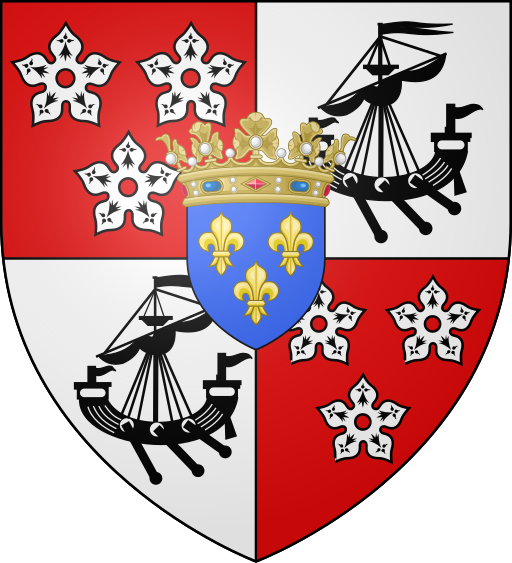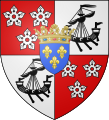| ОписArms of Hamilton, Duke of Abercorn.svg |
English: Arms of Duke of Abercorn: Quarterly: 1st & 4th, gules three cinquefoils pierced ermine (for Hamilton); 2nd & 3rd, argent, Argent, a lymphad with the sails furled and oars sable (for Arran) in the point of honour and over all, an inescutcheon azure with charged three fleur-de-lys or, and surmounted by a French ducal coronet (for Chattellerault).
Dukedom of Châtellerault
From Wikipedia:
- The French Dukedom of Châtellerault was created in 1548 for his ancestor James Hamilton, 2nd Earl of Arran (c. 1519-1575), Regent of Scotland, who arranged the marriage of Mary, Queen of Scots, to the Dauphin Francis, son of King Henry II, and who had been promised a duchy by the Treaty of Châtillon, 1548. However, he turned against the Queen in 1559, and his French estates and title were confiscated. In 1864, the Hamilton creation of 1548 was revived by the Emperor Napoleon III. However, this revival was neither in favour of the heir under the original letters patent, the 14th Earl of Derby, nor in favour of the heir-male, the 2nd Marquess of Abercorn (father of 2nd Duke of Abercorn, who erected this coat of arms), but rather in favour of the 12th Duke of Hamilton, who was a third cousin once removed of the Emperor through his mother the former Princess Marie Elisabeth of Baden. He died without male issue in 1895, and was succeeded as Duke of Hamilton by his fourth cousin Alfred, Duke of Hamilton. The Dukes of Hamilton and the Dukes of Abercorn have since then used the title in France, though without any legal justification.
Note on inescutcheon of the French Dukedom of Châtellerault
From: https://www.heraldica.org/topics/france/scotfr.htm#arran
- The title, created by the French sovereign, ultimately depends on French laws and decisions of the French sovereign. By granting title and duchy to others after 1560, the French kings clearly indicated that they did not think that the title belonged to any descendant of James Hamilton. Nor did his heirs think that it did, since none seemed to claim the title, but rather worried about the 12,000 livres rent. That rent was taken care of, and although the 1720 bankruptcy must have been a blow, it was a blow endured by all creditors of the French state alike. No one among the Hamiltons seems to have worried about the title itself until the late 18th c. On that basis, of course, Napoleon III was free to create the title again and bestow it on whomever it pleased him, but that is not what he did, since he claimed to have simply confirmed an existing title. If one follows the interpretation of the Conseil d'État, he recreated the title for the 12th duke, under unspecified terms of succession: but neither the duke of Abercorn nor the duke of Hamilton are descendants of the 12th duke of Hamilton. Even if one takes the view that Napoleon III somehow recreated the title created by the Letters Patent of 1548, following the terms of the remainder in those very Letters, the heir to the title is the earl of Derby, heir to the general line, and neither Hamilton nor Abercorn. Be that as it may, it is the case that the present duke of Abercorn has no plausible claim to the title, whether or not one takes into account the 1864 decree. Furthermore, the escutcheon which both Hamilton and Abercorn claim comes from nowhere. The only individual to have unquestionably held the title in question, that is, the grantee, apparently never used such an escutcheon, even as he used the title and coronet over his complete achievement. Furthermore, it would seem highly unusual for anyone to use a quarter or escutcheon with the arms of the king of France, unless by special grant or permission. Such a grant exists for the Stuarts of Darnley, and one can surmise that there was one for Archibald Douglas, but in both cases the grant was a quarter, not an escutcheon, and was completely independent of the title, whether a peerage or not. Thus, it cannot be said that the escutcheon of France with a ducal coronet (which no one has ever born in France) is somehow "the mark of a peerage" or the escutcheon of Châtellerault (in any event, the city of Châtellerault has its arms, namely Argent a lion gules within a bordure sable entoyré or). And, of course, under the interpretation of the 1864 decree as a new creation, one is hard put to understand why an escutcheon of the kings of France would be used to recall a title conferred by the Emperor of the French (whose arms were different). Of course, even if one decided that the escutcheon in question, in Scots heraldry, represented the duchy of Châtellerault, it would remain that only one duke could bear the escutcheon, since only one duke can hold the title. Therefore the other, whoever that might be, would be assuming illegal arms. The remaining question is: how are the arms of the dukes of Hamilton and Abercorn registered with Lord Lyon? The answer is given in Innes of Learney's Scots Heraldry, p.33. The achievement of the duke of Hamilton is shown, Quarterly 1 and 4, quarterly Hamilton and Arran, 2 and 3 Douglas, without inescutcheon, and the source is given as "1903, Lyon Register." Sir James Balfour Paul confirms that the arms registered for Hamilton are without inescutcheon. Hamilton's inescutcheon, then, is plainly in violation of the law of arms of Scotland. As for Abercorn, according to James Paul, "no arms were never registered for the earls of Abercorn, but the following [Hamilton-Arran with inescutcheon of France] were recorded in Ulster's office, Ireland, in the 'Register of Knights', 20 July 1866, on the occasion of the duke being sworn as Lord-Lieutenant." I doubt that this constitutes a legal registration of those arms. Innes of Learney discusses the use of inescutcheons: "In Scotland, the inescutcheon is often reserved for a Royal augmentation, or some highly important feudal fief or heritable office, or in other cases for the paternal arms when the shield itself is occupied with quarterings of fiefs and heiresses. […] The Scottish practice is therefore very much that of the Continent, where in the case of family arms its use often indicates the chief of the family. When, however, the inescutcheon bears the arms of a fief, the use of this marshalling indicates cadency (footnote: The duke of Abercorn, heir-male but cadet in the Hamilton family, bears an inescutcheon of “his” dukedom of Châtelherault. In Scotland his predecessors bore a label.), unless such inescutcheon is coroneted." (p.139) Another passage on marks of cadency states: "The label is the charge appropriate to be borne by the heir-male who is not the heir-of-line of his house when the principal (i.e. undifferenced) arms have gone to the heir-of-line" and a footnote says: "The Abercorn line of Hamiltons did use such a mark prior to their differencing by the inescutcheon of Chatelherault" (p. 119). These passages are puzzling: they appear to describe the inescutcheon of Abercorn as a mark of cadency, the heir to the name and arms of Hamilton being the duke of Hamilton. That mark used to be a label, the mark of cadency for the heir-male when he is not the heir of name and arms, and this label was later replaced by the inescutcheon of a fief of the Abercorn line. There are many problems with this theory: the inescutcheon used by the Abercorns is coroneted, which rules out this interpretation from the start, according to Innes of Learney's own remark; the inescutcheon in question is not that of the claimed fief; the claimed fief does not belong to the Abercorn line (note how Innes of Learney raises doubts on this point with the quotes around “his”); the Abercorn were using the label before they were heirs-male to the line (Claude, Lord Paisley and his son the 1st earl used a label, Stevenson and Wood); the Abercorns dropped the label sometime in the 17th c., used the arms without label and without inescutcheon in the 18th c., and do not appear to have used the inescutcheon until the mid-19th c., and therefore for close to 200 years did not use any mark of cadency whatsoever (cf. Debrett's Peerage, 1814, where Abercorn bears Hamilton and Arran). Such an interpretation, therefore, although apparently that of Lord Lyon, is extremely dubious. It is clear that the duke of Hamilton is violating the law of arms of Scotland, and probable that the duke of Abercorn is doing the same, possibly with the ambiguous endorsement of the Lord Lyon.
|






